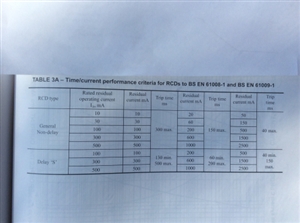Hi all
Just reading through the disconnection times in the regs and noticed something I've never thought of before.
On table 41.1 there is a note under the table that states that the disconnection times of a TT system can be the same as a TN system if disconnection is achieved by an OCPD and bonding is in place. However, I've not come across a TT system with a Ze low enough where only an OCPD can be used. The lowest Ze I've seen was 20 ohms.
Therefore:
On a TT system the disconnection times are 1 second and 0.2 of a second. Reg 411.3.2.2 & 411.3.2.4.
You would normally use an RCD for fault protection due to earth rod resistance causing higher than max Zs on final circuits as well as additional protection. Reg 411.5.3.
However, according to the OSG 11.2 and 11.3 the max allowable time to trip for a 61008 and 61009 can be up to 300ms (or, as stated, less then 300ms so 299.99ms).
If you are using RCBOs on circuits requiring 30mA protection and a selective type on the incoming it is 150 to 500ms on circuits without the RCBOs, so even worse.
This will mean it may not comply with the disconnection times. If you test the RCD and it trips within the 200ms it will comply but the fact that the BS standards allow for a longer time means that technically it does not comply.
(On a side note it seems strange that the older BS4293 RCD specifications do have a max trip time of less that 200ms, although it would still be the same issue with the selective type).

